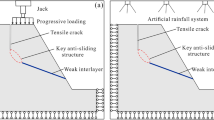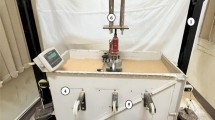Abstract
The frost resistance characteristics and deterioration law of rock masses under freeze–thaw cycles in cold regions are important prerequisites for engineering design and stability analysis. In traditional experimental research, there exists the problem of sample selection bias caused by the heterogeneity and anisotropy of the original rock samples, which leads to a large dispersion of experimental results. To mitigate this problem, using red sandstone in Ezhou as the target object, this research first established a similarity criterion formula. Then, to obtain reliable experimental results, 3-factor and 5-level orthogonal experiments were designed with the water-cement ratio, weight ratio of quartz sand and cement, and silica fume content as control factors. Finally, a freeze–thaw cycle experiment was conducted. Based on the control indices of strength and porosity, preliminary screening of the proportion was subsequently carried out by comparing the parameters of the original sandstone, and 3 schemes stood out consequently, based on which the freeze–thaw cycle experiments were conducted. Eventually, according to the similarity criteria and sensitivity factors such as weight, wave velocity and strength, the optimal quasi-sandstone material proportion scheme was determined as follows: water and cement ratio (0.42), quartz sand and cement ratio (1.1), and silica fume content (0.1%). The experimental results further reveal the deterioration law of sandstone under freeze–thaw cycles, which indicates that with the increase in freeze–thaw cycles, the frost resistance parameters of sandstone show a downward trend, and the frost resistance gradually decreases. The descending order of the sensitivity of the frost resistance indices of sandstone to the effect of freeze–thaw cycles is the strength deterioration coefficient, wave velocity deterioration coefficient, and weight loss ratio.










Similar content being viewed by others
Availability of data and material
The datasets used or analyzed during the current study are available from the corresponding author on reasonable request.
Code availability
Not applicable.
References
Behfarnia K, Salemi N (2013) The effects of nano-silica and nano-alumina on frost resistance of normal concrete. Constr Build Mater 48:580–584. https://doi.org/10.1016/j.conbuildmat.2013.07.088
Cui NK, Wang JX, Chen SL, Ge WM, Kou HJ (2020) Experimental study on mix proportion of similar materials of marl. J Highway Transportation Res Dev 37:81–88 (in Chinese). https://doi.org/10.3969/j.issn.1002-0268.2020.11.011
Fang Y, Qiao L, Chen X, Yan SJ, Zhai GL, Liang YW (2014) Experimental study of freezing-thawing cycles on sandstone in Yungang grottoes. Rock Soil Mech 35:2433–2442. (in Chinese). https://doi.org/10.16285/j.rsm.2014.09.003
Geng XY, Zhang ZX (2015) Study on preparation methods for similar materials of sandstone. Chin J Underground Space Eng 11:23–28 ((in Chinese))
Guo YH, Cao RJ, Zhu LH (2012) Research on similar material in physical specimen petrography of rock.Adv Mater Res 616–618:346–349. https://doi.org/10.4028/www.scientific.net/AMR.616-618.346
He GL, Zhang L, Wu G (2004) Test study on physical characteristics of rock under freezing-thawing cycles. Rock Soil Mech S2:52–56. (in Chinese). https://doi.org/10.16285/j.rsm.2004.s2.011
Huang S, Liu Y, Guo Y, Zhang Z, Cai Y (2019) Strength and failure characteristics of rock-like material containing single crack under freeze-thaw and uniaxial compression. Cold Reg Sci Technol 162:1–10. https://doi.org/10.1016/j.coldregions.2019.03.013
Khanlari G, Sahamieh RZ, Abdilor Y (2015) The effect of freeze–thaw cycles on physical and mechanical properties of Upper Red Formation sandstones, central part of Iran. Arab J Geosci 8:5991–6001. https://doi.org/10.1007/s12517-014-1653-y
Li CJ, L YS, Li TC, Zhu QW, Li ZC, Wang ZY (2021) Experimental study on influencing factors of mechanical properties for mudstone similar material. Safety in Coal Mines 52:71–76. (in Chinese). https://doi.org/10.13347/j.cnki.mkaq.2021.01.013
Li B (2015) Experimental study of rock similar material. Chongqing University. (in Chinese)
Liu JL, Wang MJ, Zhang D (2017) Study on similar model of high pressure water jet impacting coal rock. AIP Conference Proceedings AIP Publishing LLC 1864(1):020181. https://doi.org/10.1063/1.4992998
Liu H, Niu FJ, Xu ZY, Lin ZJ, Xu J (2011) Acoustic experimental study of two types of rock from the Tibetan Plateau under the condition of freeze-thaw cycles. J Glaciol Geocryol 33:557–563 ((in Chinese))
Liu YL, Zhou WZ, Guo B, Ma Q, Xiao HL (2020) Study on marl similar materials in similar simulation test. Chin J Rock Mech Eng 39:2795–2803 (in Chinese). https://doi.org/10.13722/j.cnki.jrme.2019.0885
Momeni A, Abdilor Y, Khanlari GR, Heidari M, Sepahi AA (2016) The effect of freeze–thaw cycles on physical and mechanical properties of granitoid hard rocks. B Eng Geol Environ 75:1649–1656. https://doi.org/10.1007/s10064-015-0787-9
Ren DR, Liu BG, Shi XM (2016) Experimental study on the factors affecting mechanical properties of similar material. J Beijing Jiaotong Univ 40:19–24 (in Chinese). https://doi.org/10.11860/j.issn.1673-0291.2016.06.004
Shen Y, Yang G, Huang H, Rong T, Jia H (2018) The impact of environmental temperature change on the interior temperature of quasi-sandstone in cold region: Experiment and numerical simulation. Eng Geol 239:241–253. https://doi.org/10.1016/j.enggeo.2018.03.033
Shen YJ, Rong TL, Yang GS, Yuan YZ, Yang Y, Yu X (2016) Experimental study on ratio of quasi-sandstone similar material. Adv Sci Technol Water Resources 36(04):75–79 (in Chinese). https://doi.org/10.3880/j.issn.1006-7647.2016.04.014
Shen YJ, Yang GS, Rong TL, Liu H, Lv WY (2016) Proposed scheme for freeze-thaw cycle tests on rock. Chin J Geotech Eng 38(10):1775–1782 (in Chinese). https://doi.org/10.11779/CJGE201610005
Tan X, Chen W, Yang J, Cao J (2011) Laboratory investigations on the mechanical properties degradation of granite under freeze–thaw cycles. Cold Reg Sci Technol 68:130–138. https://doi.org/10.1016/j.coldregions.2011.05.007
Wang JX, Cui NK, Lin YX, Ge WM, Kou HJ (2021) Preliminary application of similar materials development and model test of phyllite. Chin J Underground Space Eng 17:87–97 ((in Chinese))
Wang YY, G XN, Fan XY, Zhu SW, Zhang JL (2017) Research on the preparation and mechanical properties of a kind of material similar to shale. Shandong Sci 30(4):50–57 (in Chinese). https://doi.org/10.3976/j.issn.1002-4026.2017.04.009
Wang XX, Shen XD, Wang HL, Gao C, Zhao HX, Gao ML (2014) Frost-resistance of natural pumice concrete due to salt corrosion and freeze-thaw circulation. J Chin Ceramic Soc 42:1414–1421 (in Chinese). https://doi.org/10.7521/j.issn.0454-5648.2014.11.11
Wu Y (2018) Study on strength, damage and creep characteristics of rock-like materials under freeze-thaw cycle. Qingdao University of Science and Technology (in Chinese)
Zhang SP, Deng M, Tang MS (2008) Advance in research on damagement of concrete due to freeze thaw cycles. J Mater Sci Eng 26:990–994 ((in Chinese))
Acknowledgements
The work described herein is fully supported by the National Natural Science Foundation of China (Grant Nos. 41572281 and 42072309). Special thanks are owed to Faculty of Engineering, China University of Geosciences (Wuhan) for sharing their test devices to make this project possible.
Funding
This research was funded by the National Natural Science Foundation of China (Grant No. 41572281 and 42072309).
Author information
Authors and Affiliations
Contributions
Conceptualization, Methodology, Writing—original draft preparation: XH. Writing—original draft preparation, formal analysis and investigation: NJ Methodology, Funding acquisition, Supervision: XL. Writing—review and editing: XY and MH.
Corresponding author
Ethics declarations
Conflict of interest
The authors declare no conflict of interest.
Additional information
Publisher's Note
Springer Nature remains neutral with regard to jurisdictional claims in published maps and institutional affiliations.
Rights and permissions
About this article
Cite this article
He, X., Jiang, N., Luo, X. et al. Experimental Research on the Proportion of Quasi-Sandstone Materials Based on Frost Resistance Characteristics. Geotech Geol Eng 40, 3943–3955 (2022). https://doi.org/10.1007/s10706-022-02062-4
Received:
Accepted:
Published:
Issue Date:
DOI: https://doi.org/10.1007/s10706-022-02062-4




